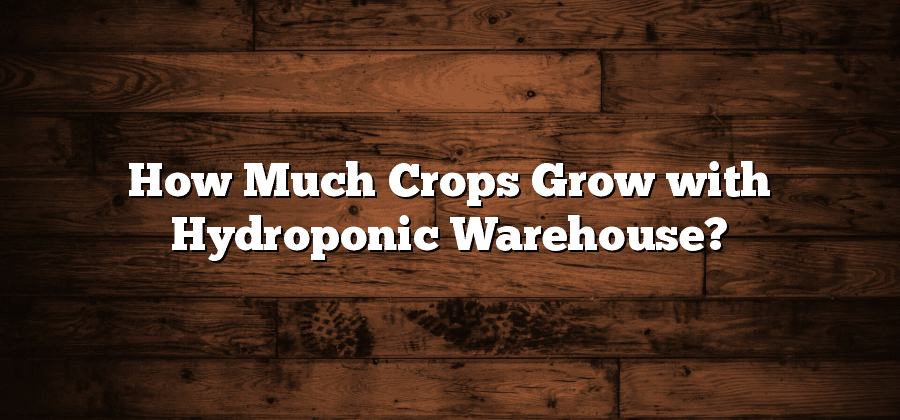Benefits of hydroponic farming in warehouses
Hydroponic farming in warehouses offers numerous benefits for growers and the environment. Firstly, by utilizing vertical farming techniques, growers can maximize their use of space, allowing for higher crop yields compared to traditional farming methods. This is especially beneficial in urban areas where land is limited. Additionally, hydroponics eliminates the need for soil, reducing the risk of soil-borne diseases and pests. This eliminates the need for pesticide and herbicide use, resulting in cleaner and healthier produce.
Furthermore, hydroponic farming in warehouses allows for year-round production, regardless of external weather conditions. This greatly reduces the reliance on seasonal harvests and ensures a steady supply of fresh produce. Moreover, the controlled environment of a warehouse allows growers to optimize the growing conditions for each crop, resulting in faster growth rates, improved plant health, and higher-quality yields.
Overall, hydroponic farming in warehouses represents a sustainable and efficient solution to meet the growing demand for fresh produce while minimizing the environmental impact of traditional farming practices.
Factors affecting crop growth in hydroponic warehouses
Factors affecting crop growth in hydroponic warehouses can vary greatly and significantly impact the overall success of the cultivation process. One key factor is the nutrient solution used to nourish the plants. It is essential to maintain the correct balance of nutrients to ensure optimal growth. Too much or too little of certain elements can lead to nutrient deficiencies or toxicities, stunting the plants’ growth and reducing yields.
Another vital factor is the pH level of the nutrient solution. Hydroponic plants thrive best in a slightly acidic environment, typically between 5.5 and 6.5. Maintaining the correct pH helps the plants effectively absorb essential nutrients. If the pH is too high or too low, nutrient availability can be disrupted, leading to nutrient uptake issues and poor growth. Continuous monitoring and adjustment of the pH level are crucial for ensuring optimal conditions for crop growth in hydroponic warehouses.
Best crops to grow in hydroponic warehouses
When it comes to hydroponic farming in warehouses, choosing the right crops is crucial for success. Certain crops are better suited for hydroponic systems due to their ability to thrive and produce high yields in this controlled environment. Leafy greens such as lettuce, spinach, and kale are popular choices for hydroponic warehouses. These crops have shallow root systems and can efficiently absorb nutrients and water from the hydroponic solution. Additionally, herbs like basil, mint, and chives are well-suited for hydroponic cultivation, as they can be grown in smaller spaces and have a high market demand. These crops not only offer a quick turnaround time but also provide a consistent supply to meet the increasing demand for fresh, locally grown produce.
Another crop that has gained popularity in hydroponic warehouses is strawberries. Growing strawberries hydroponically allows for tight control over their growing conditions, resulting in sweeter and juicier fruits. The vertical growing systems commonly used in warehouses make efficient use of space and maximize the crop yield per square foot. With year-round production, hydroponic strawberries can be grown and harvested consistently, providing a profitable option for growers looking to diversify their crop selection.
Overall, the choice of crops for hydroponic warehouses should be based on market demand, space availability, and the efficiency of using hydroponics for their cultivation. By selecting the right crops, growers can ensure a successful and profitable venture in the field of hydroponic farming within warehouse settings.
Techniques for maximizing crop yield in hydroponic warehouses
One key technique for maximizing crop yield in hydroponic warehouses is the regular monitoring and adjustment of nutrient levels. Unlike traditional soil-based farming, hydroponics requires precise control over the nutrient solution that is provided to the plants. Regular testing of the nutrient solution can help identify any deficiencies or imbalances, allowing for targeted adjustments to ensure the plants receive the optimal nutrients they need for healthy growth and maximum yield. By closely monitoring and adjusting the nutrient levels, hydroponic farmers can optimize plant growth and productivity.
Another technique for maximizing crop yield in hydroponic warehouses is the implementation of proper plant spacing and pruning techniques. In hydroponics, space is often limited, and it is important to maximize the utilization of available growing area. By spacing plants appropriately, growers can ensure that each plant receives adequate access to light, air, and nutrients. Additionally, regular pruning helps to maintain plant health and encourages the growth of strong, productive branches. Proper plant spacing and pruning not only prevent overcrowding and competition for resources but also promote airflow and reduce the risk of disease and pest infestation.
Importance of proper lighting in hydroponic farming
Proper lighting plays a crucial role in hydroponic farming, as it directly impacts the growth and development of plants. In the absence of natural sunlight, artificial lighting sources are used to provide the necessary light spectrum needed for photosynthesis. This ensures that plants receive the right amount and quality of light, enabling them to flourish and produce high-quality yields.
The use of artificial lighting allows growers to have better control over the growth process, as they can adjust the intensity, duration, and color spectrum of the light according to specific crop requirements. This flexibility is especially beneficial for hydroponic warehouses as it allows for year-round production without being dependent on external factors such as seasonal changes or weather conditions. Moreover, proper lighting in hydroponic farming aids in reducing the growth cycle of plants, resulting in shorter cultivation periods and increased overall productivity.






